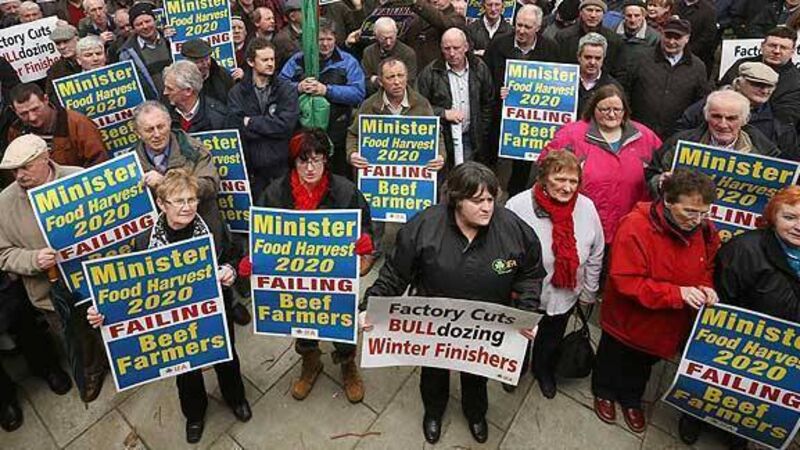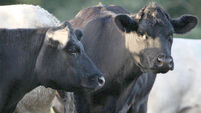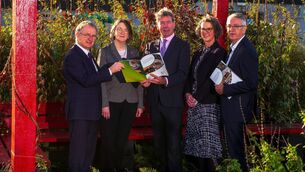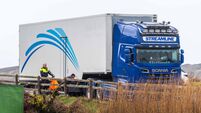Irish agri-food on the cusp of an historic era of opportunity

WHEN the dust settles on the new CAP, farmers will see the new model is balanced and the funding is fairly distributed across all farm classes, says IFA president Eddie Downey.
Some quarters have argued that the IFA’s role in the background to the CAP debate has been to protect “ranchers” over small farmers. This criticism has also included East vs West and Rich vs Poor aspects, with the more critical commentators arguing that some farmers on smaller, lesser quality holdings would fare worse under the new CAP.
However, Eddie Downey says protecting vulnerable farmers is a core goal for the IFA. He said the IFA’s single greatest achievement has been Farm Assist, which has given some degree of security to the most vulnerable farmers, and getting a Government commitment to 40% rural development co-financing has also been critical for Irish farming.
He has been attending meetings with farmers in recent weeks, discussing CAP and other issues, and says that there is far higher farmer awareness of the benefits of the Irish ‘approximation’ model for CAP over the EU’s proposed ‘regionalisation’ model than some commentators realise.
“I am a mid-sized farmer and I am losing money,” said Mr Downey, who farms 140 acres of tillage and sucklers, plus intensive poultry, in Slane, Co Meath, with his wife Mary, their son Patrick and their daughter Alice.
“I have no Pillar II payment myself. I will see my Single Farm Payment reduced. We are vulnerable to CAP, and there is nothing we can do about it other than try to work my farm to meet the new regulations and where they are going.”
According to its president, IFA is now focused on ensuring that Pillar II payments are driven towards small and mid-sized farmers, and it has fought to protect poorer farmers under Pillar I, citing the €20 per hectare being paid to Scottish farmers in upland and poor land, versus at least €150/ha being paid to all Irish farmers.
Eddie Downey said members attending IFA meetings in Galway ten days ago realised that Irish farmers have done well to keep €200m in disadvantaged area payments, €250m under GLAS, another €250m in suckler welfare payments and grassland payments of €15m to €18m. Achieving the fairest possible distribution of that money is a top IFA priority. “When the dust settles on this CAP, farmers will see that it is fairer than ever,” said Mr Downey. “We met 450 people in Galway last week and there was very little dissatisfaction. I asked beef farmers were they happy with CAP, and they said they were not unhappy with how it turned out. When a farmer is ‘not unhappy’, that’s as close as you’ll get to he or she saying they’re ‘happy’.
“The reality is that people can see this has been a balanced reform, and now we are trying to get Pillar II into poorer areas.
“The department ran regional meetings at which people accepted that the approximation model was better, as it avoided regionalisation, and that it is giving farmers a fairer result.”
IFA commitments
Meanwhile, with the Department of Agriculture having delivered CAP reform, IFA’s commitment to the Government is three-fold:
nIncreased farm output.
nPublic goods — maintaining the countryside, etc.
nSupporting agri-food jobs.
Downey says IFA is very optimistic about the future of farming, and views Ireland as being ideally placed to deliver high quality, traceable and certified food to a steadily rising global population.
With the end of 31 years of dairy output restrictions now imminent, IFA is advising farmers to be careful in how they approach the opportunity this presents.
Cautious on debt
Historically, Irish farmers have always been resistant to taking on debts, and with good reason. While Danish dairy farmers are carrying around €19,000 in debts per cow, Holland around €13,000 per cow, and there are similarly high debt levels in the US, NZ and Canada, Irish debt levels of around €2,000 per cow are relatively low.
Irish farmers have also a good history of repaying their debts. As a result, the Irish banks understandably view agri-food as a good investment, and the subject of a lot of data crunching and analysis in their IT departments.
“A good track record does count for something,” said Eddie Downey. “Farmers have a well-established, good record for repaying their debts, which is recognised by the banks. We also need flexibility in both the banking and the taxation systems to facilitate growth in the sector.
“There has been steady growth in agri-food, but the rate of growth seemed small during the Celtic Tiger years compared to some other sectors. Suddenly, now people can see the value of agri-food, they can see the great growth plan for the sector and the opportunities for dairy, tillage, beef and sheep etc.
“This will be a five-year or a ten-year investment. Ireland will export 90% of its agri-food output. When you take this road, you must be cautious how you do it.”
The IFA leader also said Ireland must remember that it is just one player within the European market, working within rules that continue to define Ireland’s global ambitions. Some 30 years ago, Europe was the world’s largest agri-food exporter; now it is a net importer.
End of quota era
Decades of output restrictions, as well as the EU’s positions on GM technologies and climate change, will continue to impact on how Ireland competes with net exporters such as the US, NZ and Australia.
However, with a growing consumer focus on food safety in key markets such as Asia, the EU regulatory environment could prove beneficial for Ireland. IFA believes Ireland’s quality assurance schemes for beef and dairy, plus Bord Bia’s Origin Green promotional drive, will give Irish agri-food an unique appeal to global consumers. “We have a great advantage here on the edge of Europe with our grass-based and safe traceable food,” said Eddie Downey. “Our Angus and Hereford steak are market leaders in terms of quality. Kerrygold is the leading branded butter in Germany. We could well become the Texas of Europe.”
Domestic challenges
However, while conscious of the opportunity, Eddie Downey said IFA remains conscious of challenges such as the rising cost of doing business in Ireland, rising banking costs, transport and Government charges for services. Farmers, like other consumers, also face rising costs of education, heating, lighting and grocery bills.
Farmers tend to support their own community, and IFA urges other consumers to do likewise, with Downey saying a big plus from Government commitment to agri-food is that almost every euro invested tends to stay within the domestic economy.
Support local
“We try to support local businesses where possible,” he said.
“Farmers always try to shop local, but they have to shop sharp also. They always look for a reasonable price, but their local co-op knows that, and generally delivers the best value.
“We would like to see this commitment reflected in the general retail sector. Farmers and farming families are consumers too. Irish agri-food is supporting over 300,000 jobs. In the last 12 months, we are seeing a change in the retail sector, which is starting to try to build a long term relationship with its food suppliers.
“We must make sure that below-cost selling is outlawed. We had 10,000 farmers protesting on the streets of Dublin calling for legislation to bring fairness to the retail sector. This needs to be moved on apace. The UK has done it, and there’s no reason why we can’t do it here.”









